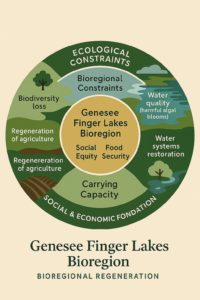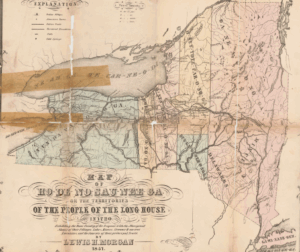 The framework we have described for assessing the health of the Genesee Finger Lakes Bioregion was developed and enhanced using AI — ChatGPT, Gemini, and Grammarly, to mention a few. Is this legitimate? Is it useful? This article uses AI to address these questions.
The framework we have described for assessing the health of the Genesee Finger Lakes Bioregion was developed and enhanced using AI — ChatGPT, Gemini, and Grammarly, to mention a few. Is this legitimate? Is it useful? This article uses AI to address these questions.
To begin with, ChatGPT alerts us to something that a wise human might say: “To use the best of AI to help regenerate the Genesee Finger Lakes bioregion, we can focus on AI as a partner in place-based, life-centered work—not a substitute for human or ecological wisdom.”
That being said, “here’s a strategy in five interconnected areas:”
- Mapping & Sensing the Bioregion
- Bioregional Knowledge Commons
- Participatory Planning & Decision Support
- Climate Resilience & Regenerative Economy
- Creative Engagement, Storytelling, and Education
- Mapping & Sensing the Bioregion
AI can:
- Integrate satellite imagery, drones, and ground-level sensors to map:
- Watersheds, wetlands, forests, farms, urban areas
- Biodiversity, soil health, invasive species
- Detect environmental changes (e.g., algal blooms, flooding risks, deforestation) in real-time
- Create interactive bioregional maps with cultural, ecological, and historical layers
Example: Use AI to monitor Canandaigua Lake’s health or detect urban heat islands in Rochester.
- Bioregional Knowledge Commons
 Use AI to help gather, organize, and share:
Use AI to help gather, organize, and share:
- Oral histories, traditional ecological knowledge, indigenous place names
- Local policy data, land use patterns, zoning rules
- Regenerative case studies from farmers, community organizers, and cooperatives
Tool: A natural language AI interface that helps anyone — student or elder — query and contribute to a bioregional database.
- Participatory Planning & Decision Support
AI can:
- Run scenario simulations (e.g., impacts of different land use or climate strategies)
- Facilitate collaborative design of green infrastructure, agroforestry, or transit systems
- Support distributed governance — summarizing input from assemblies, highlighting consensus or divergence
Imagine: A community can ask: “What happens to our watershed if we restore 30% of riparian buffers?” — and AI runs the models.
- Climate Resilience & Regenerative Economy
AI can:
- Help design C-PACE-backed regenerative retrofits or energy projects
- Optimize local supply chains (e.g., food systems, fiber, biochar, water reuse)
- Assist in modeling carbon drawdown potential for soils, wetlands, or forest corridors
Example: AI-supported cooperative platforms for regional food and energy sovereignty.
- Creative Engagement, Storytelling, and Education
Use generative AI for:
- Storyweaving: Personal and ecological stories that connect people to place
- Bioregional media: Maps, murals, videos, and immersive digital environments
- Custom curriculum: Place-based educational tools for schools, libraries, nature centers
Think: AI helping a 12-year-old and an elder write a children’s book about the life of the Genesee River.
Key Principles to Follow
- Ethical AI: Transparent, inclusive, and aligned with regenerative values — not extractive or corporate-owned.
- Human-in-the-loop: Always centered on people and ecosystems, with AI as a tool, not decision-maker.
- Place-based customization: Trained on local data, not generalized models from elsewhere.
- Open-source and community-owned: Part of the Commons, not controlled by a few.
Here are some further examples of how AI could be used to evaluate and monitor the ecological, economic, social, and cultural health of the Genesee Finger Lakes Bioregion:
🌿 Ecological Health
- Remote Sensing + AI Image Analysis
- Use satellite imagery + machine learning to monitor land cover changes, forest health, agricultural practices, urban sprawl, and water quality (e.g., detecting algal blooms in Finger Lakes).
- AI models can identify biodiversity hotspots, deforestation, soil degradation, and wetland loss at high resolution.
- Wildlife and Biodiversity Monitoring
- Deploy AI-trained camera traps and acoustic sensors in parks and natural areas to automatically detect and identify species (including endangered ones).
- Track migration patterns and population trends over time, especially for key indicator species like eagles, salamanders, and trout.
- Watershed Health Modeling
- Combine real-time water sensor data with AI to predict harmful algal blooms, nutrient runoff hotspots, and stream health.
- Use AI hydrological models to assess the impact of land use changes on flooding risk and aquifer recharge.
🏛️ Economic Health
- AI-based Economic Resilience Index
- Build a dashboard using local economic data (business formation, unemployment rates, income levels, small farm viability) and AI analysis to assess the resilience of local economies.
- Forecast the impact of climate change (e.g., drought, severe storms) on key industries like agriculture, tourism, and manufacturing.
- Smart Agriculture and Food Systems
- Apply AI to analyze soil health data, crop yield predictions, and local food system resilience.
- Support regenerative farming practices by identifying optimal planting strategies and climate-adaptive cropsfor the region.
👫 Social Health
- Social Cohesion and Equity Mapping
- Use AI to process data from surveys, social media, and civic engagement platforms to evaluate community trust, inclusiveness, and social capital across towns and neighborhoods.
- Map gaps in healthcare access, housing affordability, education equity, and public transportation availability.
- Mental and Physical Health Indicators
- Analyze anonymized public health data to detect trends in mental health, opioid addiction, nutrition, and chronic illness across the bioregion.
- Identify where investments in wellness infrastructure (e.g., parks, clinics, mental health services) are most needed.
🎨 Cultural Health
- Cultural Vitality and Heritage Monitoring
- Map the presence and activity levels of museums, libraries, arts organizations, Indigenous cultural centers, and historic sites.
- Use AI text analysis on local newspapers, event listings, and social media to measure cultural participation rates and public sentiment about community identity.
- Language, Storytelling, and Knowledge Preservation
- Support the documentation and revitalization of Indigenous and local place-based knowledge using natural language AI tools.
- AI could help digitize and map oral histories, traditional ecological knowledge, and local storytelling traditions to preserve them for future generations.
🚀 Integrated Bioregional Health Dashboard
- AI-powered Bioregional Regeneration Platform
- Bring all of this together into an interactive dashboard that visualizes real-time bioregional health metrics across ecological, economic, social, and cultural dimensions.
- Use predictive AI models to simulate different future scenarios: What happens if we regenerate 10% more farmland? If we restore 3,000 acres of wetlands? If we expand public transit?
Such a platform could guide participatory decision-making, support grant applications, and inspire collective action toward regenerating the Genesee Finger Lakes Bioregion.